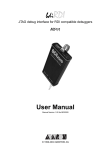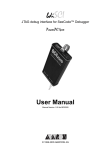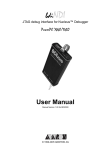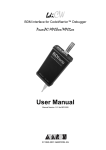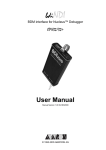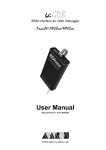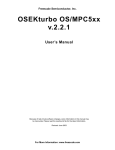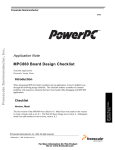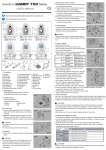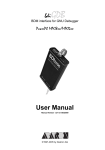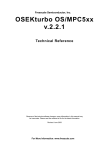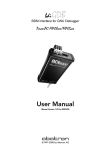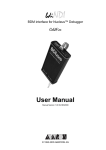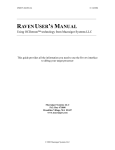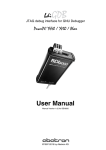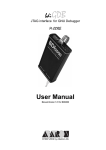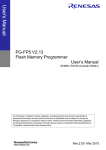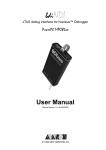Download bdiHCI_UserManual_MPC5xx8xx
Transcript
bdiHCI
BDM interface for HI-WAVE™ Debugger
PowerPC MPC8xx/MPC5xx
User Manual
Manual Version 1.06 for BDI2000
© 1992-2003 ABATRON AG
bdiHCI
BDM interface for HI-WAVE™ Debugger, BDI2000 (MPC5xx/8xx)
User Manual
2
1 Introduction ................................................................................................................................. 3
1.1 BDI2000................................................................................................................................. 3
2 Installation ................................................................................................................................... 4
2.1 Connecting the BDI2000 to Target......................................................................................... 4
2.1.1 Changing Target Processor Type ................................................................................. 6
2.2 Connecting the BDI2000 to Power Supply............................................................................. 7
2.2.1 External Power Supply ................................................................................................. 7
2.2.2 Power Supply from Target System ............................................................................... 8
2.3 Status LED «MODE»............................................................................................................. 9
2.4 Connecting the BDI2000 to the Host ................................................................................... 10
2.4.1 Serial line communication .......................................................................................... 10
2.4.2 Ethernet communication ............................................................................................ 11
2.5 Installation of the Configuration Software ............................................................................ 12
2.6 Configuration ....................................................................................................................... 13
2.6.1 BDI2000 Setup/Update .............................................................................................. 13
3 Init List........................................................................................................................................ 15
4 BDI working modes................................................................................................................... 16
4.1 Startup Mode ....................................................................................................................... 17
4.1.1 Startup mode RESET ................................................................................................ 17
4.1.2 Startup Mode STOP................................................................................................... 17
4.1.3 Startup mode RUN..................................................................................................... 17
5 Working with HI-WAVE .............................................................................................................. 18
5.1 Setup ................................................................................................................................... 18
5.2 Direct Commands ................................................................................................................ 19
5.2.1 Target.Reset ............................................................................................................... 19
5.2.2 Flash.Setup ................................................................................................................ 19
5.2.3 Flash.Erase ................................................................................................................ 20
5.2.4 Flash.Load ................................................................................................................. 22
5.2.5 Flash.Idle.................................................................................................................... 22
5.3 Download to Flash Memory................................................................................................. 22
5.4 PPC Interrupt Handling........................................................................................................ 24
6 Specifications ............................................................................................................................ 25
7 Environmental notice ................................................................................................................ 26
8 Declaration of Conformity (CE) ................................................................................................ 26
9 Warranty ..................................................................................................................................... 27
Appendices
A Troubleshooting ........................................................................................................................ 28
B Maintenance .............................................................................................................................. 29
C Trademarks ................................................................................................................................ 31
© Copyright 1992-2003 by ABATRON AG
V 1.06
bdiHCI
BDM interface for HI-WAVE™ Debugger, BDI2000 (MPC5xx/8xx)
User Manual
3
1 Introduction
Target System
Target System
MPC
5xx8xx
MPC
5xx8xx
BDM Interface
BDI2000
BDM Interface
BDI2000
PC Host
HI-WAVE
Abatron AG
Abatron AG
Swiss Made
RS232
Swiss Made
Ethernet (10 BASE-T)
The BDI2000 adds Background Debug Mode features to the HI-WAVE debugger environment. With
the BDI2000, you control and monitor the microcontroller solely through the stable on-chip debugging
services. You won’t waste time and target resources with a software ROM monitor, and you eliminate
the cabling problems typical of ICE’s. This combination runs even when the target system crashes
and allows developers to continue investigating the cause of the crash.
A RS232 interface with a maximum of 115 kBaud and a 10Base-T Ethernet interface is available for
the host interface.
The bdiHCI setup software is used to update the firmware and to configure the BDI2000 so it works
with the HI-WAVE debugger.
1.1 BDI2000
The BDI2000 is a processor system in a small box. It implements the interface between the BDM pins
of the target CPU and a 10Base-T Ethernet / RS232 connector. BDI2000 is powered by a MC68360,
512Kbyte RAM and a flash memory of 1024Kbyte. As a result of consistent implementation of lasted
technology, the BDI2000 is optimally prepared for further enhancements. The firmware and the programmable logic of the BDI2000 can be updated by the user with a simple Windows based configuration program. The BDI2000 supports 1.8 – 5.0 Volts target systems (3.0 – 5.0 Volts target systems
with Rev. A/B).
© Copyright 1992-2003 by ABATRON AG
V 1.06
bdiHCI
BDM interface for HI-WAVE™ Debugger, BDI2000 (MPC5xx/8xx)
User Manual
4
2 Installation
2.1 Connecting the BDI2000 to Target
The cable to the target system is a ten pin flat ribbon cable. In case where the target system has an
appropriate connector, the cable can be directly connected. The pin assignment is in accordance with
the Motorola specification.
!
In order to ensure reliable operation of the BDI (EMC, runtimes, etc.) the target cable length must not
exceed 20 cm (8").
Rev. A
«Rev. A» is the first BDI2000 version, produced until June 1999
Target System
9
1
MPC
8xx
Target Connector
2
10
BDI2000
BDI
Abatron AG
TRGT MODE
BDI MAIN
9
1
10
2
BDI OPTION
1 - VFLS0
2 - SRESET
3 - GROUND
4 - DSCK
5 - GROUND
6 - VFLS1
7 - HRESET
8 - DSDI
9 - Vcc Target
10 - DSDO
Swiss Made
The green LED «TRGT» marked light up when target is powered up
Rev B/C
Target System
9
1
MPC
8xx
Target Connector
2
10
BDI2000
BDI
Abatron AG
TRGT MODE
TARGET A
9
1
10
2
TARGET B
1 - VFLS0
2 - SRESET
3 - GROUND
4 - DSCK
5 - GROUND
6 - VFLS1
7 - HRESET
8 - DSDI
9 - Vcc Target
10 - DSDO
Swiss Made
The green LED «TRGT» marked light up when target is powered up
For BDI MAIN / TARGET A connector signals see table on next page.
© Copyright 1992-2003 by ABATRON AG
V 1.06
bdiHCI
BDM interface for HI-WAVE™ Debugger, BDI2000 (MPC5xx/8xx)
User Manual
5
BDI MAIN / TARGET A Connector Signals:
Pin
Name
Describtion
1
VFLS0
These pin and pin 6 (VFLS1) indicate to the debug port controller whether or not the MPC
is in debug mode. When both VFLS0 and VFLS1 are at "1", the MPC is in debug mode.
2
SRESET
This is the Soft-Reset bidirectional signal of the MPC8xx. On the MPC5xx it is an output.
The debug port configuration is sampled and determined on the rising-edge of SRESET
(for both processor families). On the MPC8xx it is a bidirectional signal which may be driven
externally to generate soft reset sequence. This signal is in fact redundant regarding the
MPC8xx debug port controller since there is a soft-reset signal integrated within the debug
port protocol. However, the local debug port controller uses this signal for compatibility with
MPC5xx existing boards and s/w.
3+5
GND
System Ground
4
DSCK
Debug-port Serial Clock
During asynchronous clock mode, the serial data is clocked into the MPC according to the
DSCK clock. The DSCK serves also a role during soft-reset configuration.
6
VFLS1
These pin and pin 1 (VFLS0) indicate to the debug port controller whether or not the MPC
is in debug mode. When both VFLS0 and VFLS1 are at "1", the MPC is in debug mode.
7
HRESET
This is the Hard-Reset bidirectional signal of the MPC. When this signal is asserted (low)
the MPC enters hard reset sequence which include hard reset configuration. This signal is
made redundant with the MPC8xx debug port controller since there is a hard-reset command integrated within the debug port protocol.
8
DSDI
Debug-port Serial Data In
Via the DSDI signal, the debug port controller sends its data to the MPC. The DSDI serves
also a role during soft-reset configuration.
9
Vcc Target
1.8 – 5.0V:
This is the target reference voltage. It indicates that the target has power and it is also used
to create the logic-level reference for the input comparators. It also controls the output logic
levels to the target. It is normally fed from Vdd I/O on the target board.
3.0 – 5.0V with Rev. A/B :
This input to the BDI2000 is used to detect if the target is powered up. If there is a current
limiting resistor between this pin and the target Vdd, it should be 100 Ohm or less.
10
DSDO
Debug-port Serial Data Out
DSDO is clocked out by the MPC according to the debug port clock, in parallel with the
DSDI being clocked in. The DSDO serves also as "READY" signal for the debug port controller to indicate that the debug port is ready to receive controller’s command (or data).
Mention of sources used: MPC860ADS User’s Manual, Revision A
Enhanced Debug Mode Detection:
For MPC8xx and MPC555 targets, debug mode (Freeze) detection also works when the BDM connector pins VFLS0 and VFLS1 are not connected to the target. If not connected to VFLSx, this BDM
connector pins should be left open or tied to Vcc. The BDI uses the following algorithm to check if the
target is in debug mode (freezed):
BOOL PPC_TargetFreezed(void) {
if ((VFLS0 != 1) | (VFLS0 != 1)) return FALSE;
read debug port status;
if (status == freezed) return TRUE;
else
return FALSE;
© Copyright 1992-2003 by ABATRON AG
V 1.06
bdiHCI
BDM interface for HI-WAVE™ Debugger, BDI2000 (MPC5xx/8xx)
User Manual
6
2.1.1 Changing Target Processor Type
Before you can use the BDI2000 with an other target processor type (e.g. CPU32 <--> PPC), a new
setup has to be done (see Appendix A). During this process the target cable must be disconnected
from the target system. The BDI2000 needs to be supplied with 5 Volts via the BDI OPTION connector (Rev. A) or via the POWER connector (Rev. B/C). For more information see chapter 2.2.1
«External Power Supply».
!
To avoid data line conflicts, the BDI2000 must be disconnected from the target system while
programming the logic for an other target CPU.
© Copyright 1992-2003 by ABATRON AG
V 1.06
bdiHCI
BDM interface for HI-WAVE™ Debugger, BDI2000 (MPC5xx/8xx)
User Manual
7
2.2 Connecting the BDI2000 to Power Supply
2.2.1 External Power Supply
The BDI2000 needs to be supplied with 5 Volts (max. 1A) via the BDI OPTION connector (Rev. A) or
via POWER connector (Rev. B/C). The available power supply from Abatron (option) or the enclosed
power cable can be directly connected. In order to ensure reliable operation of the BDI2000, keep
the power supply cable as short as possible.
!
For error-free operation, the power supply to the BDI2000 must be between 4.75V and 5.25V DC.
The maximal tolerable supply voltage is 5.25 VDC. Any higher voltage or a wrong polarity
might destroy the electronics.
Rev. A
BDI OPTION
Connector
BDI
TRGT MODE
BDI MAIN
BDI OPTION
13
1
2
14
Vcc
GND
The green LED «BDI» marked light up when 5V power is connected to the BDI2000
B/C
Rev. B
Version
GND 3
RS232
BDI
TRGT MODE
POWER
Connector
1 Vcc
2
4
POWER
TARGET A
LI
1 - NOT USED
2 - GROUND
3 - NOT USED
4 - GROUND
5 - NOT USED
6 - GROUND
7 - NOT USED
8 - GROUND
9 - NOT USED
10 - GROUND
11 - NOT USED
12 - Vcc (+5V)
13 - Vcc Target (+5V)
14 - Vcc (+5V)
TX RX
10 BASE-T
1 - Vcc (+5V)
2 - VccTGT
3 - GROUND
4 - NOT USED
TARGET B
The green LED «BDI» marked light up when 5V power is connected to the BDI2000
Please switch on the system in the following sequence:
• 1 --> external power supply
• 2 --> target system
© Copyright 1992-2003 by ABATRON AG
V 1.06
bdiHCI
BDM interface for HI-WAVE™ Debugger, BDI2000 (MPC5xx/8xx)
User Manual
8
2.2.2 Power Supply from Target System
The BDI2000 needs to be supplied with 5 Volts (max. 1A) via BDI MAIN target connector (Rev. A) or
via TARGET A connector (Rev. B/C). This mode can only be used when the target system runs with
5V and the pin «Vcc Target» is able to deliver a current up to 1A@5V. For pin description and layout
see chapter 2.1 «Connecting the BDI2000 to Target». Insert the enclosed Jumper as shown in figure
below. Please ensure that the jumper is inserted correctly.
!
For error-free operation, the power supply to the BDI2000 must be between 4.75V and 5.25V DC.
The maximal tolerable supply voltage is 5.25 VDC. Any higher voltage or a wrong polarity
might destroy the electronics.
Rev. A
BDI OPTION
Connector
BDI
TRGT MODE
BDI MAIN
BDI OPTION
1
13
2
14
Jumper
The green LEDs «BDI» and «TRGT» marked light up when target is powered up
and the jumper is inserted correctly
Rev. B/C
3
RS232
BDI
TRGT MODE
POWER
Connector
1
2
4
POWER
TARGET A
1 - NOT USED
2 - GROUND
3 - NOT USED
4 - GROUND
5 - NOT USED
6 - GROUND
7 - NOT USED
8 - GROUND
9 - NOT USED
10 - GROUND
11 - NOT USED
12 - Vcc (+5V)
13 - Vcc Target (+5V)
14 - Vcc BDI2000 (+5V)
Jumper
LI
TX RX
10 BASE-T
1 - Vcc BDI2000 (+5V)
2 - Vcc Target (+5V)
3 - GROUND
4 - NOT USED
TARGET B
The green LEDs «BDI» and «TRGT» marked light up when target is powered up
and the jumper is inserted correctly
© Copyright 1992-2003 by ABATRON AG
V 1.06
bdiHCI
BDM interface for HI-WAVE™ Debugger, BDI2000 (MPC5xx/8xx)
User Manual
9
2.3 Status LED «MODE»
The built in LED indicates the following BDI states:
Rev. A
BDI
TRGT MODE
BDI MAIN
BDI OPTION
Rev. B/C
BDI
TRGT MODE
MODE LED
TARGET A
TARGET B
BDI STATES
OFF
The BDI is ready for use, the firmware is already loaded.
ON
The power supply for the BDI2000 is < 4.75VDC.
BLINK
The BDI «loader mode» is active (an invalid firmware is loaded or loading firmware is active).
© Copyright 1992-2003 by ABATRON AG
V 1.06
bdiHCI
BDM interface for HI-WAVE™ Debugger, BDI2000 (MPC5xx/8xx)
User Manual
10
2.4 Connecting the BDI2000 to the Host
2.4.1 Serial line communication
The host is connected to the BDI through the serial interface (COM1...COM4). The communication
cable between BDI and Host is a serial cable (RXD / TXD are crossed). There is the same connector
pinout for the BDI and for the Host side (Refer to Figure below).
Rev. A
RS232 Connector
Target System
12345
(for PC host)
MPC
5xx8xx
1 - NC
2 - RXD data from host
3 - TXD data to host
4 - NC
5 - GROUND
6 - NC
7 - NC
8 - NC
9 - NC
6789
RS232
LI
TX
RX
10 BASE-T
BDI2000
PC Host
Abatron AG
Swiss Made
RS232
Rev. B/C
Target System
RS232 Connector
(for PC host)
12345
MPC
5xx8xx
1 - NC
2 - RXD data from host
3 - TXD data to host
4 - NC
5 - GROUND
6 - NC
7 - NC
8 - NC
9 - NC
6789
RS232
POWER
LI
TX RX
10 BASE-T
BDI2000
PC Host
Abatron AG
Swiss Made
RS232
© Copyright 1992-2003 by ABATRON AG
V 1.06
bdiHCI
BDM interface for HI-WAVE™ Debugger, BDI2000 (MPC5xx/8xx)
User Manual
11
2.4.2 Ethernet communication
The BDI2000 has a built-in 10 BASE-T Ethernet interface (see figure below). Connect an UTP (Unshilded Twisted Pair) cable to the BD2000. For thin Ethernet coaxial networks you can connect a
commercially available media converter (BNC-->10 BASE-T) between your network and the
BDI2000. Contact your network administrator if you have questions about the network.
Rev. A
1
8
10 BASE-T
Connector
1 - TD+
2 - TD3 - RD+
4 - NC
5 - NC
6 - RD7 - NC
8 - NC
RS232
LI
TX
RX
10 BASE-T
Target System
Rev. B/C
1
RS232
POWER
LI
TX RX
8
MPC
5xx8xx
10 BASE-T
BDI2000
PC Host
Abatron AG
Swiss Made
Ethernet (10 BASE-T)
The following explains the meanings of the built-in LED lights:
LED
Name
Description
LI
Link
When this LED light is ON, data link is successful between the UTP
port of the BDI2000 and the hub to which it is connected.
TX
Transmit
When this LED light BLINKS, data is being transmitted through the UTP
port of the BDI2000
RX
Receive
When this LED light BLINKS, data is being received through the UTP
port of the BDI2000
© Copyright 1992-2003 by ABATRON AG
V 1.06
bdiHCI
BDM interface for HI-WAVE™ Debugger, BDI2000 (MPC5xx/8xx)
User Manual
12
2.5 Installation of the Configuration Software
On the enclosed diskette you will find the BDI configuration software and the firmware required for
the BDI. Copy all these files to a directory on your hard disk.
The following files are on the diskette:
b20mpc.exe
Configuration program
b20mpc.hlp
Helpfile for the configuration program
b20ppcfw.xxx
Firmware for BDI2000 for MPC8xx/MPC5xx targets
ppcjed20.xxx
JEDEC file for the BDI2000 (Rev. A/B) logic device programming
ppcjed21.xxx
JEDEC file for the BDI2000 (Rev. C) logic device programming
bdiifc32.dll
BDI Interface DLL (32bit version)
*.bdi
Configuration Examples
Example of an installation process:
• Copy the entire contents of the enclosed diskette into a directory on the hard disk.
• You may create a new shortcut to the b20mpc.exe configuration program.
© Copyright 1992-2003 by ABATRON AG
V 1.06
bdiHCI
BDM interface for HI-WAVE™ Debugger, BDI2000 (MPC5xx/8xx)
User Manual
13
2.6 Configuration
Before you can use the BDI together with the debugger, the BDI must be configured. Use the SETUP
menu and follow the steps listed below:
• Load or update the firmware / logic, store IP address
--> Firmware
• Set the communication parameters between Host and BDI
--> Communication
• Setup an initialization list for the target processor
--> Initlist
• Select the working mode
--> Mode
• Transmit the configuration to the BDI
--> Mode Transmit
For information about the dialogs and menus use the help system (F1).
2.6.1 BDI2000 Setup/Update
First make sure that the BDI is properly connected (see Chapter 2.1 to 2.4). The BDI must be connected via RS232 to the Windows host.
!
To avoid data line conflicts, the BDI2000 must be disconnected from the target system while
programming the logic for an other target CPU (see Chapter 2.1.1).
The following dialogbox is used to check or update the BDI firmware and logic and to set the network
parameters.
dialog box «BDI2000 Update/Setup»
The following options allow you to check or update the BDI firmware and logic and to set the network
parameters:
Channel
Select the communication port where the BDI2000 is connected during
this setup session.
Baudrate
Select the baudrate used to communicate with the BDI2000 loader during
this setup session.
© Copyright 1992-2003 by ABATRON AG
V 1.06
bdiHCI
BDM interface for HI-WAVE™ Debugger, BDI2000 (MPC5xx/8xx)
User Manual
14
Connect
Click on this button to establish a connection with the BDI2000 loader.
Once connected, the BDI2000 remains in loader mode until it is restarted
or this dialog box is closed.
Current
Press this button to read back the current loaded BDI2000 software and
logic versions. The current loader, firmware and logic version will be displayed.
Update
This button is only active if there is a newer firmware or logic version
present in the execution directory of the BDI setup software. Press this
button to write the new firmware and/or logic into the BDI2000 flash memory / programmable logic.
IP Address
Enter the IP address for the BDI2000.
Use the following format: xxx.xxx.xxx.xxxe.g.151.120.25.101
Ask your network administrator for assigning an IP address to this
BDI2000. Every BDI2000 in your network needs a different IP address.
Subnet Mask
Enter the subnet mask of the network where the BDI is connected to.
Use the following format: xxx.xxx.xxx.xxxe.g.255.255.255.0
A subnet mask of 255.255.255.255 disables the gateway feature.
Ask your network administrator for the correct subnet mask.
Default Gateway
Enter the IP address of the default gateway. Ask your network administrator for the correct gateway IP address. If the gateway feature is disabled,
you may enter 255.255.255.255 or any other value..
Transmit
Click on this button to store the network configuration in the BDI2000 flash
memory.
In rare instances you may not be able to load the firmware in spite of a correctly connected BDI (error
of the previous firmware in the flash memory). Before carrying out the following procedure, check
the possibilities in Appendix «Troubleshooting». In case you do not have any success with the
tips there, do the following:
• Switch OFF the power supply for the BDI and open the unit as
described in Appendix «Maintenance»
• Place the jumper in the «INIT MODE» position
• Connect the power cable or target cable if the BDI is powered
from target system
• Switch ON the power supply for the BDI again and wait until the
LED «MODE» blinks fast
INIT MODE
• Turn the power supply OFF again
DEFAULT
• Return the jumper to the «DEFAULT» position
• Reassemble the unit as described in Appendix «Maintenance»
© Copyright 1992-2003 by ABATRON AG
V 1.06
bdiHCI
BDM interface for HI-WAVE™ Debugger, BDI2000 (MPC5xx/8xx)
User Manual
15
3 Init List
dialog box «Startup Init List»
In order to prepare the target for debugging, you can define an Initialization List. This list is stored in
the Flash memory of the BDI2000 and worked through every time the target comes out of reset. Use
it to get the target operational after a reset. The memory system is usually initialized through this list.
After processing the init list, the RAM used to download the application must be accessible.
Use on-line help (F1) and the supplied configuration examples on the distribution disk to get more
information about the init list.
Note:
You may also use the debuggers feature to setup the hardware. But keep in mind, that the BDI will
speed up BDM communication clock after processing its own initialization list based on the «Clock
Rate» field in the «BDI Working Mode» dialog box (see next chapter). The «Clock Rate» value you
have to enter is therefore the value the target runs immediately after reset.
To use a BDM speed as fast as possible, you should at least speed up the target with an entry in the
BDI initialization list and set the «Clock Rate» field to the appropriate value. The rest of the initialization (e.g. memory controller) can be done with the debugger.
© Copyright 1992-2003 by ABATRON AG
V 1.06
bdiHCI
BDM interface for HI-WAVE™ Debugger, BDI2000 (MPC5xx/8xx)
User Manual
16
4 BDI working modes
dialog box «BDI Working Mode»
With this dialog box you can define how the BDI interacts with the target system.
Identification
Enter a text to identify this setup. This text can be read by the debugger
with the appropriate Command.
Startup
Startup mode defines how the BDI interacts with the target processor after
reset or power up. The options RESET, STOP or RUN can be selected.
Breakpoint
Breakpoint mode defines how instruction breakpoints are implemented.
When Software is selected (default), instruction breakpoints are set as requested by the debugger (Software or Hardware breakpoints). When
Hardware is selected, the BDI uses always hardware breakpoints. This is
useful when the attached debugger does not support hardware breakpoints on instruction access.
CPU Type
Select the CPU type of the target system.
Clock Rate
Enter the clock rate the target CPU runs after BDI has worked through the
init list. BDI selects the BDM communication speed based on this parameter. If this parameter selects a CPU clock rate that is higher than the real
clock rate, BDM communication may fail. When selecting a clock rate
slower than possible, BDM communication still works but not as fast as
possible.
Workspace
In order to access the floating-point registers of a MPC5xx microprocessor, the BDI needs a workspace of 8 bytes in target RAM. Enter the base
address of this RAM area. This memory is used, when a floating-point register is accessed. If there is no RAM space available for the BDI, you may
enter 0xFFFFFFFF as the workspace address but then, accessing floating-point registers is not possible.
Transmit
Click on this button to send the initialization list and the working mode to
the BDI. This is normally the last step done before the BDI can be used
with the debugging system.
© Copyright 1992-2003 by ABATRON AG
V 1.06
bdiHCI
BDM interface for HI-WAVE™ Debugger, BDI2000 (MPC5xx/8xx)
User Manual
17
4.1 Startup Mode
Startup mode defines how the BDI interacts with the target system after a reset or power up
sequence.
4.1.1 Startup mode RESET
In this mode no ROM is required on the target system. The necessary initialization is done by the BDI
with the programmed init list. The following steps are executed by the BDI after system reset or
system power up:
• HRESET is activated on the target system.
• HRESET is deactivated and the target is forced into debug mode.
• The BDI works through the initialization list and writes to the corresponding addresses.
The RESET mode is the standard working mode. Other modes are used in special cases (i.e.
applications in ROM, special requirements on the reset sequence...).
4.1.2 Startup Mode STOP
In this mode the initialization code is in a ROM on the target system. The code in this ROM handles
base initialization. At the end of the code, the initialization program enters an endless loop until it is
interrupted by the BDI. This mode is intended for special requirements on the reset sequence (e.g.
loading a RAM based programmable logic device).
In this mode the following steps are executed by the BDI after system reset or power up:
• HRESET is activated on the target system.
• HRESET is deactivated and the target is forced into debug mode.
• The target is started and begins executing application code.
• After a delay of 2 seconds, the target is forced into debug mode.
• The BDI works through the initialization list and writes the corresponding addresses.
4.1.3 Startup mode RUN
This mode is used to debug applications which are already stored in ROM. The application is started
normally and is stopped when the debugger is started.
In this mode, the following steps are executed by the BDI after system reset or power up:
• HRESET is activated on the target system.
• HRESET is deactivated and the target is forced into debug mode.
• The target is startet and begins executing application code.
• The application runs until it is stopped by the debugger.
© Copyright 1992-2003 by ABATRON AG
V 1.06
bdiHCI
BDM interface for HI-WAVE™ Debugger, BDI2000 (MPC5xx/8xx)
User Manual
18
5 Working with HI-WAVE
5.1 Setup
There are three environment variables concerning the interface between HI-WAVE and the BDI2000.
The first one (BDI_LINK) defines the communication channel used. The second one
(BDI_COMPRESS) defines if data compression should be used when downloading via an asynchronous communication channel (e.g. COM1). The third one (BDI_VERIFY) defines data verification
during program download.
BDI_LINK
For communication via a serial communication port use the following initialization
string:
Syntax: BDI_LINK=COMn baudrate
n:Number of used COM port (1,2,3,4)
baudrate:The baudrate (9600, 19200, 38400, 57600, 115200). Use the baudrate
selected in menu Setup->Communication.
Example: BDI_LINK=COM1 57600
For communication via an Ethernet use the following initialization string:
Syntax: BDI_LINK=NETWORK ipaddress 1
ipaddress:The IP address of the BDI2000 (Format: xxx.xxx.xxx.xxx).
Example: BDI_LINK=NETWORK 151.120.25.101 1
BDI_COMPRESS
By default, data compression is enabled for asynchronous communication channels.
With older computers, it’s possible that download speed is faster without data compression. With this environment variable you can disable data compression.
Syntax: BDI_COMPRESS=ON | OFF | 0 | 1
Example: BDI_COMPRESS=OFF
BDI_VERIFY
This variable defines if download data is read back from target memory and compared
against the written data.
Syntax: BDI_VERIFY=NO | FIRST | FULL | 0 | 1 | 2
NO (0):No read back at all.
FIRST (1):The first byte of every download block is read back and verified.
FULL (2):Every byte is read back and verified.
Example: BDI_VERIFY=FIRST
Example:
......
BDI_LINK=NETWORK 151.120.25.101 1
BDI_COMPRESS=ON
BDI_VERIFY=FIRST
......
© Copyright 1992-2003 by ABATRON AG
V 1.06
bdiHCI
BDM interface for HI-WAVE™ Debugger, BDI2000 (MPC5xx/8xx)
User Manual
19
5.2 Direct Commands
For special functions the BDI supports so called «Direct Commands». This commands can be used
interactively in the HI-WAVE Command Line Window or entered in a command file (e.g. PRELOAD.CMD). This Direct Commands are not interpreted by HI-WAVE but directly sent to the BDI. After processing the command the result is displayed in the Command Line Window.
Use the following syntax to enter a Direct Command:
BDI <direct-command>
Direct Commands are ASCII - Strings with the following structure:
<Object>.<Action> [<ParName>=<ParValue>]...
Example:
flash.erase addr=0x02800000
All names are case insensitive. Parameter values are numbers or strings. Numeric parameters can
be entered as decimal (e.g. 700) or as hexadecimal (0x80000) values.
5.2.1 Target.Reset
This direct command executes a real physical reset of the target system.
5.2.2 Flash.Setup
In order to support loading into flash memory, the BDI needs some information about the used flash
devices. Before any other flash related command can be used, this direct command must be executed.
External flash memories:
Syntax:
flash.setup type=am29f size=0x80000 bus=32 workspace=0x1000
type
size
bus
workspace
This parameter defines the type of flash used. It is used to select the correct programming algorithm. The following flash types are supported:
AM29F, AM29BX8, AM29BX16, I28BX8, I28BX16, AT49, AT49X8, AT49X16,
STRATAX8, STRATAX16, MIRROR, MORRORX8, MIRRORX16,
I28BX32, AM29DX16, AM29DX32
The size of one flash chip in bytes (e.g. AM29F010 = 0x20000). This value is used to
calculate the starting address of the current flash memory bank.
The width of the memory bus that leads to the flash chips. Do not enter the width of
the flash chip itself. The parameter TYPE carries the information about the number of
data lines connected to one flash chip. For example, enter 16 if you are using two
AM29F010 to build a 16bit flash memory bank.
If a workspace is defined, the BDI uses a faster programming algorithm that run out of
RAM on the target system. Otherwise, the algorithm is processed within the BDI. The
workspace is used for a 1kByte data buffer and to store the algorithm code. There must
be at least 2kBytes of RAM available for this purpose.
© Copyright 1992-2003 by ABATRON AG
V 1.06
bdiHCI
BDM interface for HI-WAVE™ Debugger, BDI2000 (MPC5xx/8xx)
User Manual
20
MPC555 internal flash:
Syntax:
flash.setup type=mpc555 clock=20 workspace=0x007FC000
type
This parameter defines the type of flash used. Enter MPC555 or MPC555SHD when
programming the MPC555 internal flash. MPC555SHD selects the shadow information.
Enter the CPU clock frequency in MHz. The BDI needs this parameter to calculate the
program / erase pulse timing. It is important to enter the correct frequency otherwise
the erase / programming pulses are not correct.
This value defines the base address of a workspace in target RAM. The workspace is
used for a data buffer and to store the algorithm code. There must be at least 2kBytes
of RAM available for this purpose.
clock
workspace
;Setup for 20MHz, use internal SRAM array B for workspace
flash.setup type=mpc555 clock=20 workspace=0x007FC000
MPC565 internal flash:
Syntax:
flash.setup type=uc3f workspace=0x007F8000
type
This parameter defines the type of flash used. Enter UC3F or UC3FSHD when programming the MPC565 internal flash. UC3FSHD selects the shadow information.
This value defines the base address of a workspace in target RAM. The workspace is
used for a data buffer and to store the algorithm code. There must be at least 2kBytes
of RAM available for this purpose.
workspace
;Setup for MPC565, use internal CALRAM A for workspace
flash.setup type=uc3f workspace=0x007F8000
5.2.3 Flash.Erase
External flash memories:
This command allows to erase one flash sector.
Syntax:
flash.erase addr=0x02800000 mode=chip
addr
mode
The start address of the flash sector to erase.
This parameter defines the erase mode. The following modes are supported:
CHIP, BLOCK and SECTOR (default is sector erase)
© Copyright 1992-2003 by ABATRON AG
V 1.06
bdiHCI
BDM interface for HI-WAVE™ Debugger, BDI2000 (MPC5xx/8xx)
User Manual
21
MPC555 internal flash:
This command allows to erase one or multiple block(s) in one flash module.
Syntax:
flash.erase addr=0x004000FF
The BDI assumes the following structure of the address:
16 bit
module address
module address
C
block
1 bit
C
7 bit
<reserved>
8 bit
block [0:7]
The 16 most significant bits of the flash module address.
The censor bit. If this bit is set, the censor information is erased. Use with caution!
The bit mask to select the flash block to erase. Bit ordering is the same as in the CMFCTL register (see MPC555 manual).
;Erase module A/B all sectors, flash memory is mapped to 0x00400000
flash.erase addr=0x004000FF
flash.erase addr=0x004400FC
MPC565 internal flash:
This command allows to erase one or multiple block(s) in one flash module.
Syntax:
flash.erase addr=0x004000FF
The BDI assumes the following structure of the address:
16 bit
module address
module address
C
sbb*
block
1 bit
5 bit
2 bit
C <reserved> sbb[0:1]
8 bit
block [0:7]
The 16 most significant bits of the flash module address.
The censor bit. If this bit is set, the censor information is erased. Use with caution!
The bit mask to select the small blocks to erase. Bit ordering is the same as in the
UC3FCTL register (see MPC565 manual).
The bit mask to select the flash block to erase. Bit ordering is the same as in the
UC3FCTL register (see MPC565 manual).
;Erase module A/B all sectors, flash mapped to 0x00400000
;Because the DLL timeouts after 5 seconds, this is done with multiple steps
flash.erase addr=0x004000F0
flash.erase addr=0x0040000F
flash.erase addr=0x004800F0
flash.erase addr=0x0048000F
* The BDI does not write implicit any value to the UC3FMCRE registers. If small blocks are used, the
appropriate value has to be written to the UC3FMCRE registers via the BDI initialization list or via the
connected debugger.
© Copyright 1992-2003 by ABATRON AG
V 1.06
bdiHCI
BDM interface for HI-WAVE™ Debugger, BDI2000 (MPC5xx/8xx)
User Manual
22
5.2.4 Flash.Load
This command enables loading to flash memory. If the address of a data block is within the given
flash range, the BDI automatically uses the appropriate programming algorithm. This command must
be executed before downloading is started.
Syntax:
flash.load addr=0x02800000 size=0x200000
addr
size
The start address of the flash memory
The size of the flash memory
5.2.5 Flash.Idle
This command disables loading to flash memory.
Syntax:
flash.idle
5.3 Download to Flash Memory
The BDI supports download and debugging of code that runs out of flash memory. To erase the Flash
and to download code add the following entries to the command files PRELOAD.CMD and POSTLOAD.CMD.
Following an example used to download into the flash memory of the MPC860ADS.
PRELOAD.CMD:
bdi
bdi
bdi
bdi
flash.setup type=am29f size=0x80000 bus=32
flash.erase addr=0x02800000
flash.erase addr=0x02840000
flash.load addr=0x02800000 size=0x200000
POSTLOAD.CMD:
bdi flash.idle
Note:
Some Intel flash chips (e.g. 28F800C3, 28F160C3, 28F320C3) power-up with all blocks in locked
state. In order to erase/program those flash chips, use the init list to unlock the appropriate blocks.
WM16
WM16
WM16
WM16
WM16
0xFFF00000
0xFFF00000
0xFFF10000
0xFFF10000
....
0xFFF00000
0x0060
0x00D0
0x0060
0x00D0
unlock block 0
0xFFFF
select read mode
unlock block 1
© Copyright 1992-2003 by ABATRON AG
V 1.06
bdiHCI
BDM interface for HI-WAVE™ Debugger, BDI2000 (MPC5xx/8xx)
User Manual
23
Supported Flash Memories:
There are currently 3 standard flash algorithm supported. The AMD, Intel and Atmel AT49 algorithm.
Almost all currently available flash memories can be programmed with one of this algorithm. The
flash type selects the appropriate algorithm and gives additional information about the used flash.
For 8bit only flash:
AM29F (MIRROR), I28BX8, AT49
For 8/16 bit flash in 8bit mode:
AM29BX8 (MIRRORX8), I28BX8 (STRATAX8), AT49X8
For 8/16 bit flash in 16bit mode:
AM29BX16 (MIRRORX16), I28BX16 (STRATAX16), AT49X16
For 16bit only flash:
AM29BX16, I28BX16, AT49X16
For 16/32 bit flash in 16bit mode: AM29DX16
For 16/32 bit flash in 32bit mode: AM29DX32
For 32bit only flash:
I28BX32
The AMD and AT49 algorithm are almost the same. The only difference is, that the AT49 algorithm
does not check for the AMD status bit 5 (Exceeded Timing Limits).
Only the AMD and AT49 algorithm support chip erase. Block erase is only supported with the AT49
algorithm. If the algorithm does not support the selected mode, sector erase is performed. If the chip
does not support the selected mode, erasing will fail. The erase command sequence is different only
in the 6th write cycle. Depending on the selected mode, the following data is written in this cycle (see
also flash data sheets): 0x10 for chip erase, 0x30 for sector erase, 0x50 for block erase.
To speed up programming of Intel Strata Flash and AMD MirrorBit Flash, an additional algorithm is
implemented that makes use of the write buffer. This algorithm needs a workspace, otherwise the
standard Intel/AMD algorithm is used.
The following table shows some examples:
Flash
x8
x 16
x 32
Chipsize
AM29F
-
-
0x020000
Am29F800B
AM29BX8
AM29BX16
-
0x100000
Am29DL323C
AM29BX8
AM29BX16
-
0x400000
Am29PDL128G
-
AM29DX16
AM29DX32
0x01000000
Intel 28F032B3
I28BX8
-
-
0x400000
Intel 28F640J3A
STRATAX8
STRATAX16
-
0x800000
Intel 28F320C3
-
I28BX16
-
0x400000
AT49BV040
AT49
-
-
0x080000
AT49BV1614
AT49X8
AT49X16
-
0x200000
M58BW016BT
-
-
I28BX32
0x200000
SST39VF160
-
AT49X16
-
0x200000
Am29LV320M
MIRRORX8
MIRRORX16
-
0x400000
Am29F010
© Copyright 1992-2003 by ABATRON AG
V 1.06
bdiHCI
BDM interface for HI-WAVE™ Debugger, BDI2000 (MPC5xx/8xx)
User Manual
24
5.4 PPC Interrupt Handling
Almost all PPC interrupts causes an entry into debug mode. By default, the Debug Enable Register
(DER) is set as follows:
Debug Enable Register:
Bit
Mnemonic
State
Describtion
0
-
1
RSTE
enabled
Reset Interrupt
2
CHSTPE
enabled
Check Stop
3
MCIE
enabled
Maschine Check Interrupt
4-5
-
6
EXTIE
7
ALIE
enabled
Alignment Interrupt
8
PRIE
enabled
Program Interrupt
9
FPUVIE
enabled
Floating-Point Unavailable Interrupt
10
DECIE
11-12
-
13
SYSIE
enabled
System Call Interrupt
14
TRE
enabled
Trace Interrupt
15-16
-
17
SEIE
enabled
Software Emulation Interrupt
18
ITLBMSE
Implementation Specific Instructuction TLB Miss
19
ITLBERE
Implementation Specific Instructuction TLB Error
20
DTLBMSE
Implementation Specific Data TLB Miss
21
DTLBERE
Implementation Specific Data TLB Error
22-27
-
28
LBRKE
enabled
Load/Store Breakpoint Interrupt
29
IBRKE
enabled
Instruction Breakpoint Interrupt
30
EBRKE
enabled
External Breakpoint Interrupt
31
DPIE
enabled
Developement Port Nonmaskable Request
External Interrupts
Decrementer Interrupt
If this is not appropriate for the application the default initialization may be change with an entry in
the init list.
WSPR
149
0xFFE7400F
;DER: set debug enable register
If the program interrupt is disabled, only hardware breakpoints are supported.
Never disable EBRKE (Bit30) and DPIE (Bit 31) interrupts.
© Copyright 1992-2003 by ABATRON AG
V 1.06
bdiHCI
BDM interface for HI-WAVE™ Debugger, BDI2000 (MPC5xx/8xx)
User Manual
25
6 Specifications
Operating Voltage Limiting
5 VDC ± 0.25 V
Power Supply Current
typ. 500 mA
max. 1000 mA
RS232 Interface: Baud Rates
Data Bits
Parity Bits
Stop Bits
9’600,19’200, 38’400, 57’600,115’200
8
none
1
Network Interface
10 BASE-T
Serial Transfer Rate between BDI and Target
up to 16 Mbit/s
Supported target voltage
1.8 – 5.0 V (3.0 – 5.0 V with Rev. A/B)
Operating Temperature
+ 5 °C ... +60 °C
Storage Temperature
-20 °C ... +65 °C
Relative Humidity (noncondensing)
<90 %rF
Size
190 x 110 x 35 mm
Weight (without cables)
420 g
Host Cable length (RS232)
2.5 m
Specifications subject to change without notice
© Copyright 1992-2003 by ABATRON AG
V 1.06
bdiHCI
BDM interface for HI-WAVE™ Debugger, BDI2000 (MPC5xx/8xx)
User Manual
26
7 Environmental notice
Disposal of the equipment must be carried out at a designated disposal site.
8 Declaration of Conformity (CE)
© Copyright 1992-2003 by ABATRON AG
V 1.06
bdiHCI
BDM interface for HI-WAVE™ Debugger, BDI2000 (MPC5xx/8xx)
User Manual
27
9 Warranty
ABATRON Switzerland warrants the physical diskette, cable, BDI2000 and physical documentation
to be free of defects in materials and workmanship for a period of 24 months following the date of
purchase when used under normal conditions.
In the event of notification within the warranty period of defects in material or workmanship,
ABATRON will replace defective diskette, cable, BDI2000 or documentation. The remedy for breach
of this warranty shall be limited to replacement and shall not encompass any other damages, including but not limited loss of profit, special, incidental, consequential, or other similar claims.
ABATRON Switzerland specifically disclaims all other warranties- expressed or implied, including but
not limited to implied warranties of merchantability and fitness for particular purposes - with respect
to defects in the diskette, cable, BDI2000 and documentation, and the program license granted herein, including without limitation the operation of the program with respect to any particular application,
use, or purposes. In no event shall ABATRON be liable for any loss of profit or any other commercial
damage, including but not limited to special, incidental, consequential, or other damages.
Failure in handling which leads to defects are not covered under this warranty. The warranty is void
under any self-made repair operation except exchanging the fuse.
© Copyright 1992-2003 by ABATRON AG
V 1.06
bdiHCI
BDM interface for HI-WAVE™ Debugger, BDI2000 (MPC5xx/8xx)
User Manual
28
Appendices
A Troubleshooting
Problem
The firmware can not be loaded.
Possible reasons
• The BDI is not correctly connected with the target system (see chapter 2).
• The power supply of the target system is switched off or not in operating range
(4.75 VDC ... 5.25 VDC) --> MODE LED is OFF or RED
• The built in fuse is damaged --> MODE LED is OFF
• The BDI is not correctly connected with the Host (see chapter 2).
• A wrong communication port (Com 1...Com 4) is selected.
Problem
No working with the target system (loading firmware is ok).
Possible reasons
• Wrong pin assignment (BDM/JTAG connector) of the target system (see chapter 2).
• Target system initialization is not correctly --> enter an appropriate target initialization list.
• An incorrect IP address was entered (BDI2000 configuration)
• BDM/JTAG signals from the target system are not correctly (short-circuit, break, ...).
• The target system is damaged.
Problem
Network processes do not function (loading the firmware was successful)
Possible reasons
• The BDI2000 is not connected or not correctly connected to the network (LAN cable or media
converter)
• An incorrect IP address was entered (BDI2000 configuration)
© Copyright 1992-2003 by ABATRON AG
V 1.06
bdiHCI
BDM interface for HI-WAVE™ Debugger, BDI2000 (MPC5xx/8xx)
User Manual
29
B Maintenance
The BDI needs no special maintenance. Clean the housing with a mild detergent only. Solvents such
as gasoline may damage it.
If the BDI is connected correctly and it is still not responding, then the built in fuse might be damaged
(in cases where the device was used with wrong supply voltage or wrong polarity). To exchange the
fuse or to perform special initialization, please proceed according to the following steps:
!
Observe precautions for handling (Electrostatic sensitive device)
Unplug the cables before opening the cover.
Use exact fuse replacement (Microfuse MSF 1.6 AF).
Swiss Made
1.1 Unplug the cables
2
2.1 Remove the two plastic caps that cover the screws on target front side
(e.g. with a small knife)
2.2 Remove the two screws that hold the front panel
BDI
3
Abatron AG
BDI2000
1
TRGT MODE
BDI MAIN
BDI OPTION
3.1 While holding the casing, remove the front panel and the red elastig sealing
casing
elastic sealing
front panel
© Copyright 1992-2003 by ABATRON AG
V 1.06
bdiHCI
4
BDM interface for HI-WAVE™ Debugger, BDI2000 (MPC5xx/8xx)
User Manual
30
4.1 While holding the casing, slide carefully the print in position as shown in
figure below
Jumper settings
DEFAULT
INIT MODE
Fuse Position
Rev. B/C
Fuse Position
Rev. A
Pull-out carefully the fuse and replace it
Type: Microfuse MSF 1.6AF
Manufacturer: Schurter
5
Reinstallation
5.1 Slide back carefully the print. Check that the LEDs align with the holes in the
back panel.
5.2 Push carefully the front panel and the red elastig sealing on the casing.
Check that the LEDs align with the holes in the front panel and that the
position of the sealing is as shown in the figure below.
casing
elastic sealing
back panel
front panel
5.3 Mount the screws (do not overtighten it)
5.4 Mount the two plastic caps that cover the screws
5.5 Plug the cables
!
Observe precautions for handling (Electrostatic sensitive device)
Unplug the cables before opening the cover.
Use exact fuse replacement (Microfuse MSF 1.6 AF).
© Copyright 1992-2003 by ABATRON AG
V 1.06
bdiHCI
BDM interface for HI-WAVE™ Debugger, BDI2000 (MPC5xx/8xx)
User Manual
31
C Trademarks
All trademarks are property of their respective holders.
© Copyright 1992-2003 by ABATRON AG
V 1.06































